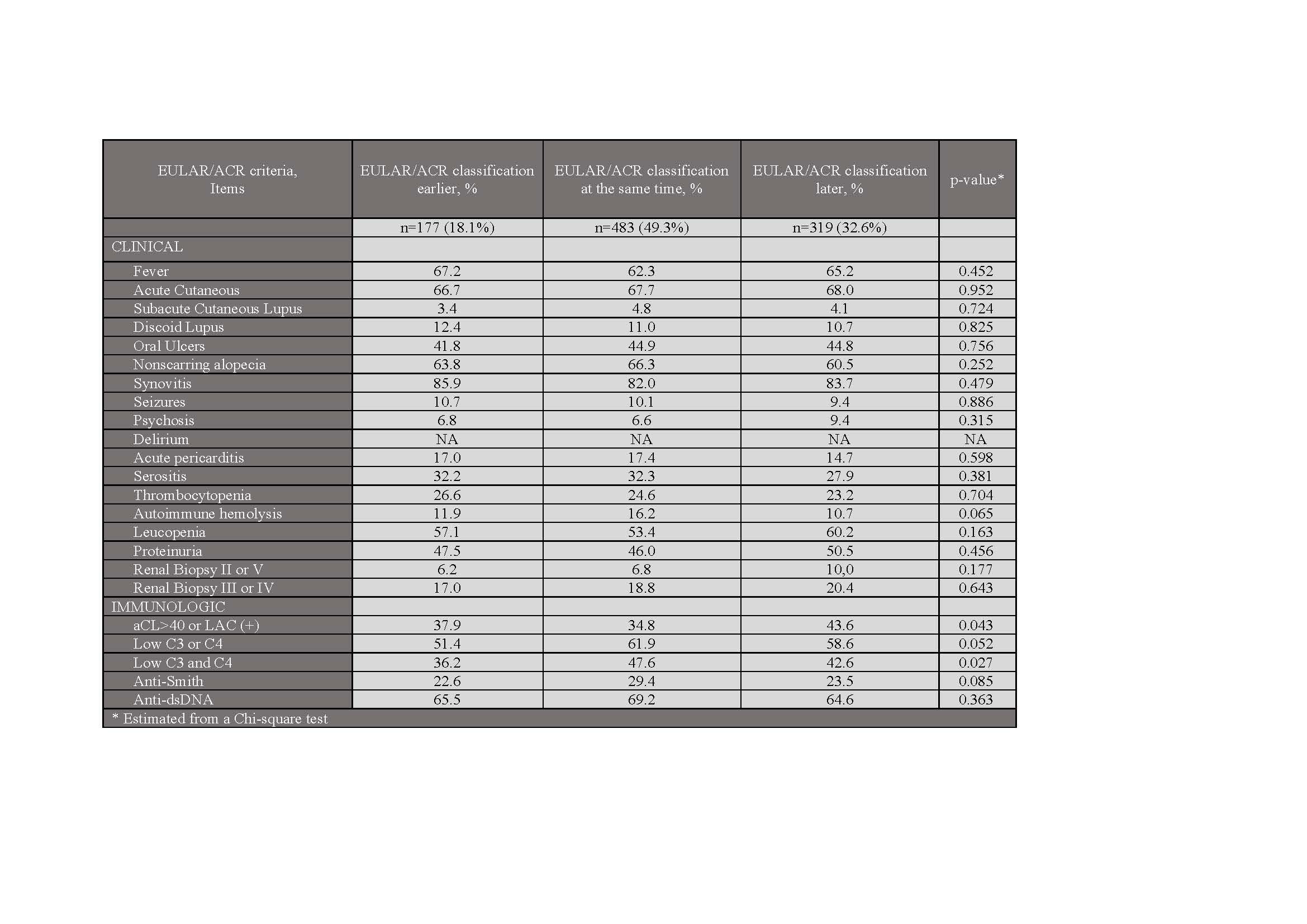Session Information
Session Type: Poster Session (Sunday)
Session Time: 9:00AM-11:00AM
Background/Purpose: Diagnosis and classification of patients as having systemic lupus erythematosus (SLE) is critical in daily clinical practice as well as for clinical trials and observational studies. The objective of this study was to identify whether patients would be classified earlier using the 2018 EULAR/ACR criteria than the physicians’ diagnosis and what items may help for the earlier diagnosis in a multiethnic lupus cohort.
Methods: Patients from a Latin American, multiethnic, multicenter cohort were included. For these analyses, the 2018 EULAR/ACR items were evaluated to determine which clinical manifestations and/or laboratory parameters could be of help to attain an earlier classification of patients. Categorical variables were compared using Chi-square. A p-value of 0.05 was set as the level of statistical significance. The statistical analyses were performed using SAS software version 9.4.
Results: One thousand forty-seven patients out of 1480 were analyzed. Of them, 979 patients fulfilled the 2018 EULAR/ACR criteria and 68 patients did not. Of those who fulfilled the 2018 EULAR/ACR criteria, the mean (±SD) age at diagnosis was 28.0 (12.5) years; 10.6% were African-Latin Americans, 38.5% Mestizos, 48.9% Caucasians, and 2.0% others. A total of 177 (18.1%) patients achieved the 2018 EULAR/ACR criteria earlier, 483 (49.3%) at the same time and 319 (32.6%) did it later. So considering patients diagnosed later (n=319) and those that could not be included (n=68), the 2018 EULAR/ACR criteria recognized as lupus at the same time or earlier, only about two-thirds [660/1047 (63%)] of the patients diagnosed by expert physicians. Patients who accrued the 2018 EULAR/ACR later were more likely to have positive anticardiolipin antibodies and/or the lupus anticoagulant; low complement levels were not uniformly distributed among the three groups but a clear pattern did not emerge. No differences were found in the clinical items of the criteria.
Conclusion: When the 2018 EULAR/ACR set of criteria were compared to the judgment of expert physicians no clinical or laboratory variable was found to allow earlier classification of lupus except for the presence of aPL antibodies which were more frequent among those diagnosed later. As compared with the physician’s clinical diagnosis, the new criteria do not seem to have a good performance for the early classification of lupus patients in this real-life scenario in a multiethnic cohort. To our knowledge this is the first independent comparison of the new proposed criteria for SLE and the gold standard diagnostic method, that is the physician’s diagnosis.
To cite this abstract in AMA style:
Serrano R, Pons-Estel G, Ugarte-Gil M, Harvey G, Wojdyla D, Saurit V, Soriano E, Bonfa E, Massardo L, Cardiel M, Quintana R, Alarcón G, Pons-Estel B. Comparison of the Physicians’ Clinical Diagnosis and the EULAR/ACR Classification Criteria for Systemic Lupus Erythematosus in a Multiethnic Cohort [abstract]. Arthritis Rheumatol. 2019; 71 (suppl 10). https://acrabstracts.org/abstract/comparison-of-the-physicians-clinical-diagnosis-and-the-eular-acr-classification-criteria-for-systemic-lupus-erythematosus-in-a-multiethnic-cohort/. Accessed .« Back to 2019 ACR/ARP Annual Meeting
ACR Meeting Abstracts - https://acrabstracts.org/abstract/comparison-of-the-physicians-clinical-diagnosis-and-the-eular-acr-classification-criteria-for-systemic-lupus-erythematosus-in-a-multiethnic-cohort/

